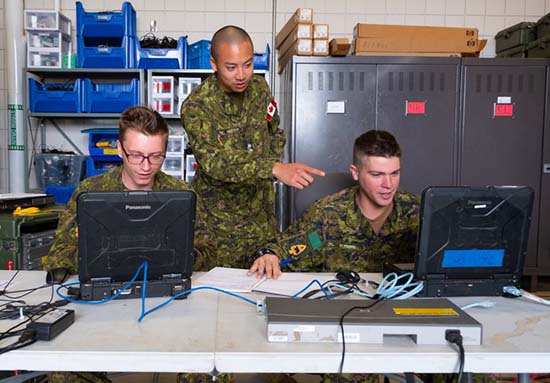Full implementation of PaCE on the new fiscal year horizon
February 25, 2022 - Defence Stories

Caption
CAF members working together, Canadian Forces Base Petawawa
Since April 2021, the Defence Team (DT) community has been has been steadily working toward full implementation of its new personnel performance appraisal tool for all Canadian Armed Forces (CAF) members, the Performance and Competency Evaluation (PaCE) system.
PaCE is an electronic based system founded on competencies required to develop successful CAF leaders who epitomize CAF values and embrace CAF objectives and strategies. It will entirely replace the current Canadian Forces Personnel Appraisal System (CFPAS) starting April 1, 2022.
The “Ready” phase of PaCE’s “Ready, Set, Go” approach saw CAF members and their supervisors through the completion of requisite training and software credential verification. Presently in the last few weeks of the “Set” phase, CAF members and their supervisors continue to gain familiarity with key features of the new system, from Job Descriptions to Member Aspiration Profiles to Feedback Notes. This preparation ensures that their full transition from CFPAS to PaCE is as seamless as possible when the new system’s “Go” phase begins in the new fiscal year.
Many CAF members are already appreciating the positive changes that PaCE brings to the performance appraisal process within the CAF. Water, Fuels and Environment Technician Master Corporal (MCpl) Matthew Lloyd of 17 Wing Winnipeg is one of them, and he recently contacted the PaCE core team to share his own reflections on the new system via a “Questions and Answers” session:
What is your favourite feature of the PaCE system and why?
Currently, I view Feedback Notes (FNs) as having the largest impact for individual CAF members. Something that really stands out to me is the level of accountability supervisors are now held to due to the recording of FNs and their associated metadata. FNs also allow members the ability to speak for themselves in order to ensure that their own perspective is heard and documented in the system. This can assist a member in verifying their own performance record. A back-and-forth discussed and agreed upon appraisal of events and outcomes will let the member know they are being heard, and it encourages their engagement in the performance review process. I believe clearly defining events and outcomes in this manner establishes both the member’s and chain of command’s responsibility for actions taken, regardless of the type of FN being given.
<Roughly how long did it take you to become comfortable using PaCE?
After completing the Common and Supervisor Defence Learning Network (DLN) PaCE courses, I was immediately held by the potential the new system would avail to all members. With only a few months of use under my belt, I do not feel entirely proficient at this time but I am getting there. I stress to my section members that the time they put in now will benefit not only them, but their subordinates as well.
In your opinion, what was the most difficult tool or concept to grasp about PaCE, and how long did it take to work through that snag?
Setting Job descriptions (JD) for myself and my team members has been the most challenging part of initiating PaCE. I worked without a base template. For this past year, I structured each entry using the six JD main headers found in the Defence Team’s Civilian Job Library (Sharepoint). I divided CFPAS’s 16 performance factors into three work characteristics categories. I created a word document first, and then formatted the content to fit the maximum character allowance within the PaCE JD text box. What I’ve developed will now benefit from additional review to fit the new CAF competencies used by PaCE.
What for you, and in a positive way, really distinguishes PaCE from CFPAS as a performance appraisal tool?
For me it comes back to the FNs feature once again. The “event/outcome” (EO) format when written for and by the member gives insight into how the member views their contribution. Reviewing FNs with a member gives them opportunity to clarify and adjust events and outcomes, insuring the full picture of their efforts is recorded and properly justified. As an example, I may have a member submit FN that I feel undervalues their performance based on how I perceived the EO. Collective review allows for the exploration of why a member holds a particular view and brings hidden considerations to light. I feel that directly involving members in this dialogue reinforces for them the effect their actions have.
Check in with your chain of command without delay to ensure that you are both ready and set to confidently “Go” with PaCE once fiscal year 2021/2022 is in the rear view, because CFPAS will be too!
To refresh your knowledge of PaCE before April 1, 2022, visit the external site (ask your chain of command for the login password), or the internal site (accessible only on the National Defence network). Questions can be sent to: PaCE-EPC@forces.gc.ca.